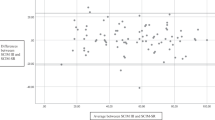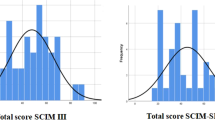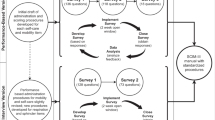Abstract
Background:
A third version of the Spinal Cord Independence Measure (SCIM III), made up of three subscales, was formulated following comments by experts from several countries and Rasch analysis performed on the previous version.
Objective:
To examine the validity, reliability, and usefulness of SCIM III using Rasch analysis.
Design:
Multicenter cohort study.
Setting:
Thirteen spinal cord units in six countries from North America, Europe, and the Middle-East.
Subjects:
425 patients with spinal cord lesions (SCL).
Interventions:
SCIM III assessments by professional staff members. Rasch analysis of admission scores.
Main outcome measures:
SCIM III subscale match between the distribution of item difficulty grades and the patient ability measurements; reliability of patient ability measures; fit of data to Rasch model requirements; unidimensionality of each subscale; hierarchical ordering of categories within items; differential item functioning across classes of patients and across countries.
Results:
Results supported the compatibility of the SCIM subscales with the stringent Rasch requirements. Average infit mean-square indices were 0.79–1.06; statistically distinct strata of abilities were 3 to 4; most thresholds between adjacent categories were properly ordered; item hierarchy was stable across most of the clinical subgroups and across countries. In a few items, however, misfit or category threshold disordering were found.
Conclusions:
The scores of each SCIM III subscale appear as a reliable and useful quantitative representation of a specific construct of independence after SCL. This justifies the use of SCIM in clinical research, including cross-cultural trials. The results also suggest that there is merit in further refining the scale.
Similar content being viewed by others
Log in or create a free account to read this content
Gain free access to this article, as well as selected content from this journal and more on nature.com
or
References
Itzkovich M et al. Rasch analysis of the Catz-Itzkovich spinal cord independence measure. Spinal Cord 2002; 40: 396–407.
Catz A, Itzkovich M, Agranov E, Ring H, Tamir A . SCIM – spinal cord independence measure: a new disability scale for patients with spinal cord lesions. Spinal Cord 1997; 35: 850–856.
Catz A et al. The Catz-Itzkovich SCIM: a revised version of the Spinal Cord Independence Measure. Disability Rehabil 2001; 23: 263–268.
Catz A et al. SCIM – spinal cord independence measure (version II): sensitivity to functional changes. Harefuah (Hebrew) 2002; 141: 1025–1031.
Catz A et al. Disability assessment by a single rater or a team: a comparative study with the Catz-Itzkovich spinal cord independence measure. J Rehabil Med 2002; 34: 226–230.
Itzkovich M et al. Reliability of the Catz-Itzkovich Spinal Cord Independence Measure assessment by interview and comparison with observation. Am J Phys Med Rehabil 2003; 82: 267–272.
Catz A, Itzkovich M . Trends in the assessment of functional outcomes after spinal cord lesions. In: Soroker N, Ring H (eds) Advances in Physical and Rehabilitation Medicine. Monduzzi: Bologna 2003, pp 123–127.
Popovic MR, Thrasher TA, Adams ME, Takes V, Zivanovic V, Tonack MI . Functional electrical therapy: retraining grasping in spinal cord injury. Spinal Cord 2006; 44: 143–151.
Tesio L . Measuring person's behaviours and perceptions: Rasch analysis as a tool for rehabilitation research. J Rehabil Med 2003; 35: 1–11.
Luce RD . Dimensionally invariant numerical laws correspond to meaningful qualitative relations. Philos Sci 1978; 45: 1–16.
Wright BD, Linacre JM . Observations are always ordinal; measurements, however, must be interval. Arch Phys Med Rehabil 1989; 70: 857–860.
Rasch G . Probabilistic Models for Some Intelligence and Attainment Tests 1960. Danish Institute for Educational research. Expanded edition with foreword and afterforeword by Wright BD The University of Chicago Press: Chicago 1980 (Reprinted by MESA Press: Chicago 1993).
Andrich D . Rasch Models for Measurement. Sage Publications: Newbury Park, CA, USA 1998.
Wright BD, Stone MH . Best Test Design. Rasch measurement. MESA Press: Chicago 1979.
Wright BD, Masters GN . Rating Scale Analysis. Rasch Measurement. MESA Press: Chicago 1982.
Tesio L . Measurement in clinical versus biological medicine. The Rasch model as a bridge on a widening gap. J Appl Meas 2004; 5: 362–366.
Linacre JM, Wirght BD . Construction of measures from many-facet data. J Appl Meas 2002; 3: 486–512.
Bond TG, Fox CM . Applying the Rasch Model. Fundamental Measurement in the Human Sciences. Erlbaum Publishers: Mahwah, NJ 2001.
Penta M, Arnould C, Decrunayère C . Développer et Interpreter Une Échelle de Measure. Applications du Modèle de Rasch. Mardaga Ed Hayen: Belgium 2005.
Wright BD, Mok M . Rasch models overview. J Appl Meas 2000; 1: 83–106.
Smith RM . Fit analysis in latent trait measurement models. J Appl Meas 2000; 1: 199–218.
Bond TG . Validity and assessment: a Rasch measurement perspective. Metodologia de las Ciencias del Comportamiento 2003; 5: 179–194.
Tennant A et al. Assessing and adjusting for cross-cultural validity of impairment and activity limitation scales through differential item functioning within the framework of the Rasch model: the PRO-ESOR project. Med Care 2004; 42 (Suppl): 37–48.
Acknowledgements
This study was supported by the Unit of Medical Services, Rehabilitation Department, Israel Ministry of Defense, Toronto Rehab, and The Rick Hansen Man In Motion Foundation Research Fund. We thank Viviana Rota, Eng, from Milan, Italy, for providing helpful assistance in graphic editing. Our special thanks go to Hanne Vest Hansen, RN, from Copenhagen, Denmark, Chris Wilson (Consultant Clinical Psychologist), Mary Watkins (Assistant Psychologist), Sister Maryse Mackenzie, and Mr S Jallul, Specialist Registrar, from Oswestry, UK, to Ora Philo, RN, from Raanana, Israel, to the staff members of all the participating units, and to all the patient volunteers who took part in the study.
Author information
Authors and Affiliations
Appendix The Spinal Cord Independence Measure, Version III
Appendix The Spinal Cord Independence Measure, Version III



Rights and permissions
About this article
Cite this article
Catz, A., Itzkovich, M., Tesio, L. et al. A multicenter international study on the Spinal Cord Independence Measure, version III: Rasch psychometric validation. Spinal Cord 45, 275–291 (2007). https://doi.org/10.1038/sj.sc.3101960
Published:
Issue date:
DOI: https://doi.org/10.1038/sj.sc.3101960
Keywords
This article is cited by
-
Classification of upper-limb dysfunction severity and prediction of independence in activities of daily living after cervical spinal-cord injury
Spinal Cord (2024)
-
Ten-year trends in the treatment and intervention timing for patients with metastatic spinal tumors: a retrospective observational study
Journal of Orthopaedic Surgery and Research (2023)
-
Minimal clinically important difference (MCID) and minimal detectable change (MDC) of Spinal Cord Ability Ruler (SCAR)
Spinal Cord (2023)
-
Prevalence of an insufficient vitamin D status at the onset of a spinal cord injury – a cross-sectional study
Spinal Cord (2023)
-
Standardized administration and scoring guidelines for the Spinal Cord Independence Measure Version 3.0 (SCIM-III)
Spinal Cord (2023)



